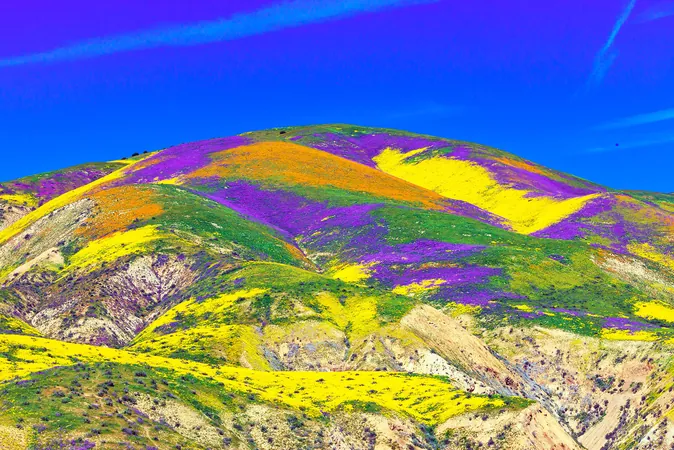
NASA Unveils Groundbreaking Techniques to Monitor Flower Cycles and Migration Patterns from Above
2025-03-26
Author: Mei
Flowers: Indicators of Ecological Balance
Flowers signify more than just the arrival of spring—they are integral components of a delicate ecological balance influenced by light, temperature, and rainfall. Recent findings suggest that tracking these seasonal rhythms through aerial technology can offer vital insights into our planet’s changing environment, especially in light of climate impacts.
Revolutionizing Plant Monitoring
In a pioneering study focused on California's wildflowers, researchers utilized advanced remote sensing technology developed by NASA’s Jet Propulsion Laboratory (JPL) to monitor flowering cycles from the sky. This approach, employing both aircraft and satellite-based instruments, successfully captured subtle variations in color that indicate the different stages of a plant's life cycle.
Collaborating with scientists from the University of Maryland-College Park, NASA's Goddard Space Flight Center employed an innovative imaging spectrometer. This sophisticated device, mounted on a plane, scanned vast areas of protected land, collecting data on light across hundreds of wavelengths—far beyond the visible spectrum that humans are capable of perceiving. This extraordinary capability allowed the team to create detailed maps of the blooming and fading cycles of flowers over a multi-month period.
David Schimel, a research scientist at JPL, declared this initiative a “first-of-a-kind study.” Monitoring plant phenology—how flowers and foliage respond to seasonal shifts—is crucial as ecosystems increasingly face the challenges posed by climate change, including rising global temperatures and altered precipitation patterns.
Challenges in Flower Tracking
Traditionally, tracking flowers has relied on field surveys and time-lapse photography, which can be limited in scope and precision. Yoseline Angel, a research scientist at both the University of Maryland-College Park and NASA’s Goddard Space Flight Center, explained that the ephemeral nature of flowers, which may only last a few weeks, complicates reliable data gathering. Instead, the study leveraged the distinct spectral fingerprints of flower colors to efficiently monitor their blooming from an aerial vantage point.
The Science of Flower Pigments
Flower colors derive from pigments that can primarily be categorized into three groups: carotenoids (yellows, oranges, reds), betalains (various hues), and anthocyanins (reds, purples, and blues). Each type absorbs and reflects light uniquely, creating identifiable spectral patterns. By employing spectrometers, researchers can now discern plant types, monitor their growth, and track blooming changes even from hundreds of miles above the Earth.
In a notable 2022 test, the Airborne Visible/InfraRed Imaging Spectrometer – Next Generation (AVIRIS-NG) conducted flights over two nature reserves in Santa Barbara County, California, gathering data from native species like Coreopsis gigantea and Artemisia californica. With refined methods, the team achieved an impressive 80% accuracy in identifying flowering stages, further validating the efficacy of this technology.
Implications for Agriculture and Ecology
The implications of this research are vast. With approximately 90% of all terrestrial plant species being flowering plants, remote sensing can improve our understanding of tipping points in ecosystems, enhance agricultural productivity, and support conservation efforts. This technological advancement promises to assist farmers and land managers in optimizing their practices, particularly regarding crops that rely heavily on flowering plants and the pollinators they attract.
Angel is currently testing similar methods using data from NASA's EMIT (Earth Surface Mineral Dust Source Investigation), which operates from the International Space Station. While primarily focused on mineral dust, EMIT also detects plant pigments, hinting at the potential for predicting rare and extraordinary events such as “superblooms,” where vast stretches of desert bloom spectacularly after heavy rains.
The Enchantment of Superbloom Events
Superblooms are a magnificent natural phenomenon, occurring when a rare combination of climatic conditions ignites a transformative explosion of flowers across previously dormant landscapes. Regions like California’s deserts showcase these awe-inspiring displays, turning valleys into vibrant carpets of color, with orange poppies, purple lupines, and yellow goldfields stretching as far as the eye can see. The existence of these blooms hinges on specific climatic triggers, often after extended dry spells.
A Community Passion for Nature
A core aspect of this research, as emphasized by Angel, is the affection people hold for flowers. Her enthusiasm for tracking wildflower sightings is fueled by social media alerts, demonstrating how technology unites scientists and citizen enthusiasts alike. As flowers continue to indicate the health of our planet, advancements in remote sensing technology allow us to monitor them more closely—from terrestrial observations to aerial views, and even from the expanse of outer space.
By leveraging these innovative methods, we can deepen our understanding of plant life cycles and ecosystem dynamics, ultimately informing conservation and agricultural practices for a healthier future.
Conclusion
Published in Ecosphere, this study marks a significant step forward in the intersection of technology and ecology.



 Brasil (PT)
Brasil (PT)
 Canada (EN)
Canada (EN)
 Chile (ES)
Chile (ES)
 Česko (CS)
Česko (CS)
 대한민국 (KO)
대한민국 (KO)
 España (ES)
España (ES)
 France (FR)
France (FR)
 Hong Kong (EN)
Hong Kong (EN)
 Italia (IT)
Italia (IT)
 日本 (JA)
日本 (JA)
 Magyarország (HU)
Magyarország (HU)
 Norge (NO)
Norge (NO)
 Polska (PL)
Polska (PL)
 Schweiz (DE)
Schweiz (DE)
 Singapore (EN)
Singapore (EN)
 Sverige (SV)
Sverige (SV)
 Suomi (FI)
Suomi (FI)
 Türkiye (TR)
Türkiye (TR)
 الإمارات العربية المتحدة (AR)
الإمارات العربية المتحدة (AR)